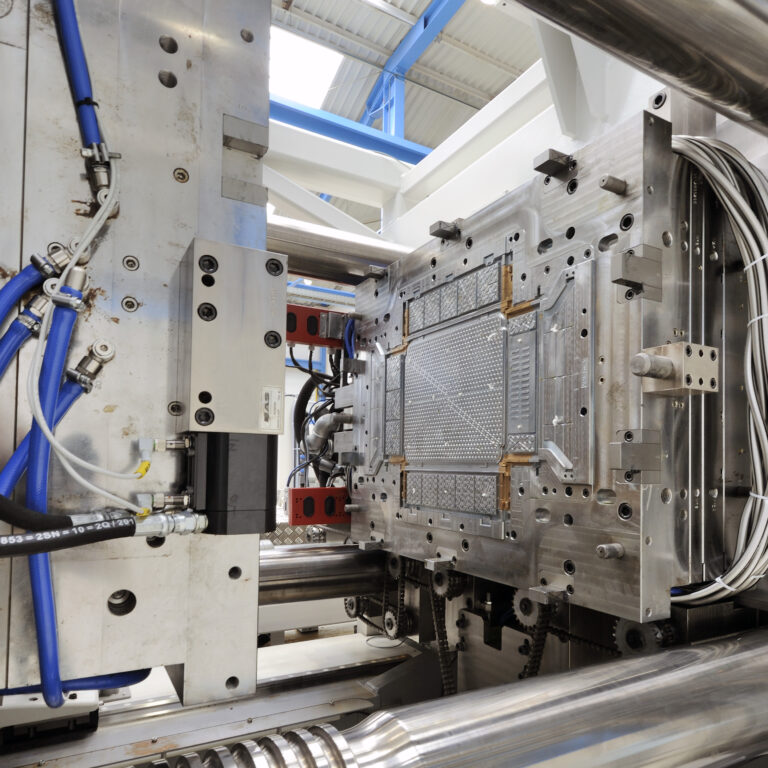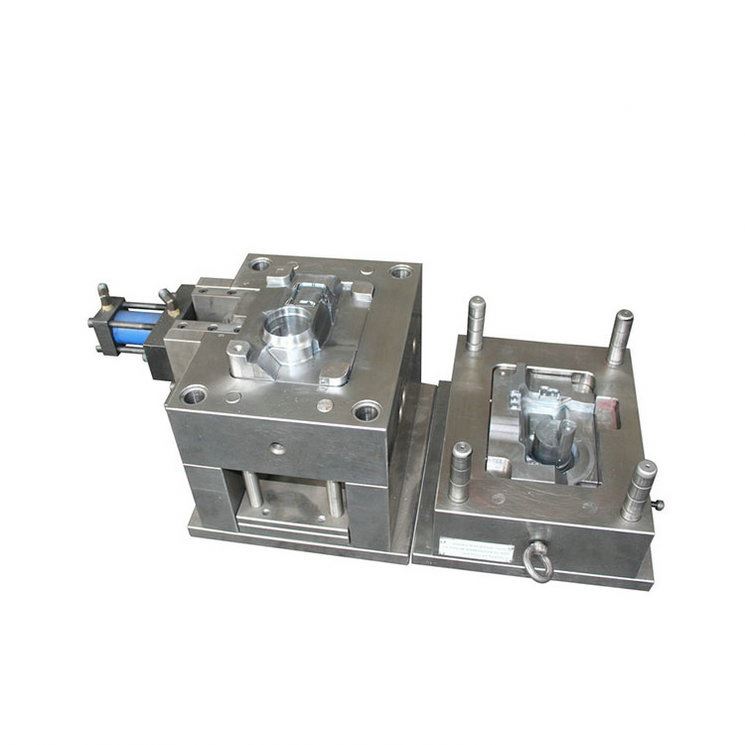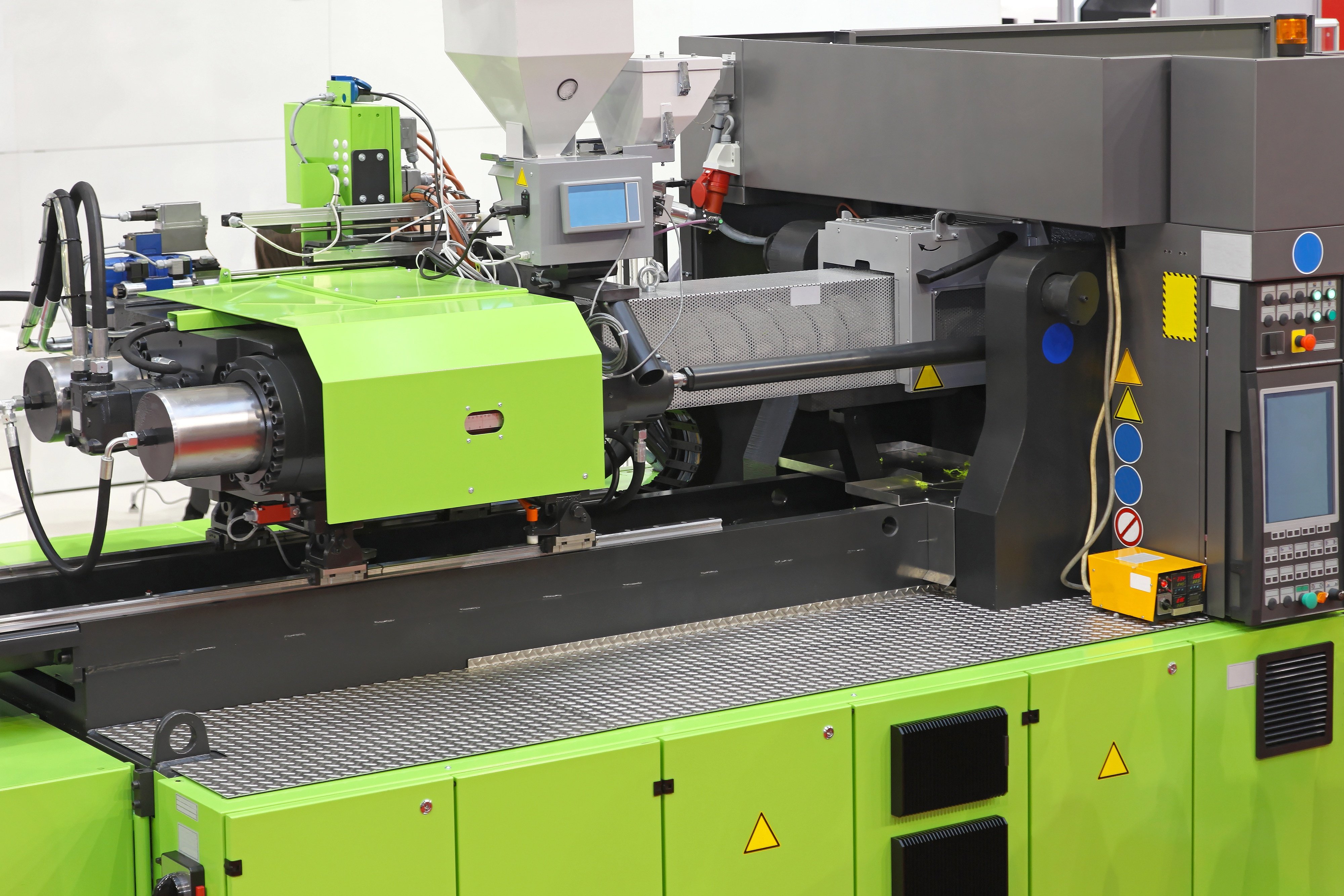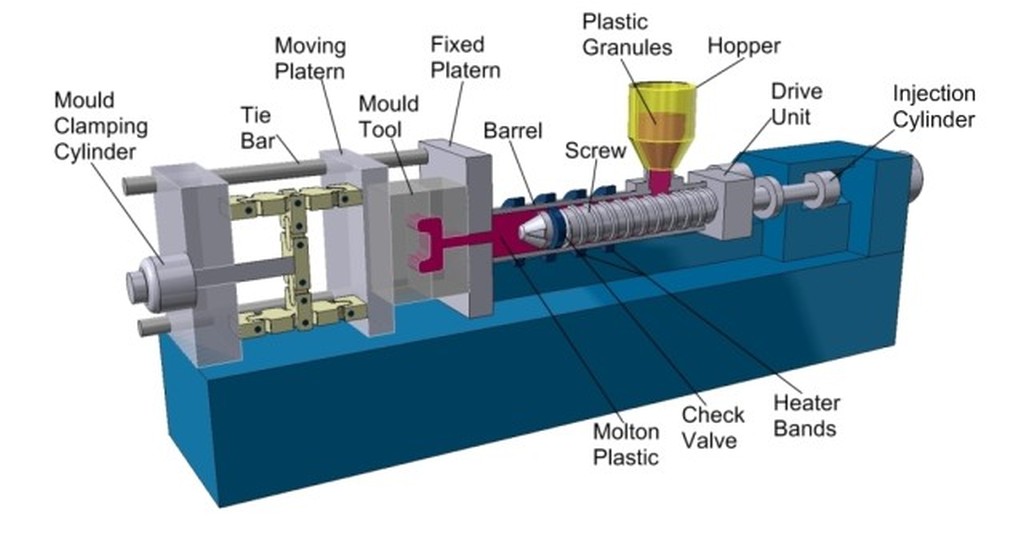What is injection moulding the guide to injection moulding
What is injection moulding?
Injection moulding is a manufacturing process in which molten materials are injected into a mould to produce various components or products. It is a highly efficient and cost-effective method of mass production, commonly used in the production of plastic parts, as well as metal, ceramic, and other materials.
The process of injection moulding involves heating the raw material, typically in the form of pellets, until it reaches a molten state. The molten material is then injected under high pressure into a pre-designed mould, which is typically made of steel or aluminum. The mould is held closed by a clamping unit, and the molten material is allowed to cool and solidify inside the mould, taking on the shape of the cavity.
The process of injection moulding is used to produce a wide variety of products, ranging from simple household items to complex components used in industries such as automotive, medical, and aerospace. It is the preferred method of production for high-volume manufacturing due to its speed, accuracy, and repeatability.
Advantages of Injection Moulding:
1. High Efficiency and Speed: Injection moulding is a highly efficient process, with cycle times ranging from a few seconds to a few minutes. This makes it ideal for mass production, as it can produce a large number of products in a relatively short period. Additionally, the use of automated machinery further increases the speed and efficiency of the process.
2. Cost-Effective: The initial cost of setting up an injection moulding operation can be high, but once the moulds are created, the cost per unit decreases significantly. This makes it a cost-effective process for high-volume production.
3. High Accuracy and Precision: Injection moulding allows for the production of highly accurate and precise components. The use of computer-aided design (CAD) and computer-aided manufacturing (CAM) tools ensures that the moulds are designed with extreme precision, resulting in consistent and high-quality products.
4. Versatility: Injection moulding is a versatile process that can be used with a variety of materials, including plastics, metals, and ceramics. This makes it suitable for the production of a wide range of products, from simple toys and household items to complex automotive parts and medical devices.
5. Minimal Waste: The use of precision moulds in injection moulding ensures that only the required amount of material is used in the production process, minimizing waste. Additionally, any excess material left over from the production process can be recycled and used in future production runs.

Process of Injection Moulding:
1. Material Selection: The first step in the injection moulding process is selecting the material to be used. The material must be suitable for the desired properties of the final product, such as strength, flexibility, and color.
2. Melting the Material: The selected material is then melted to a molten state, usually in an injection moulding machine. The temperature and pressure are carefully controlled to ensure that the material is evenly heated and reaches the desired consistency.
3. Injection: Once the material has melted, it is injected into the mould through a nozzle at high pressure. The mould is kept closed by a clamping unit to prevent any leakage of material.
4. Cooling and Solidification: After the material is injected into the mould, it is allowed to cool and solidify. The cooling time may vary depending on the material and the complexity of the product.
5. Ejection: Once the material has solidified, the mould is opened, and the product is ejected by the ejection system. This process is repeated for each cycle of production.
Technical Parameters of Injection Moulding
1. Injection Pressure: This is the pressure required to inject the molten material into the mould. It is determined by the material being used, the size and complexity of the product, and the type of machine.
2. Injection Speed: The speed at which the molten material is injected into the mould can affect the final product's surface finish and strength. Too high a speed can cause defects such as flashing, while too low a speed can result in incomplete filling of the mould.
3. Holding Pressure: After the molten material is injected into the mould, holding pressure is applied to pack the material tightly and ensure a uniform product density. The holding pressure is typically lower than the injection pressure.
4. Cooling Time: The cooling time is the period required for the molten material to solidify and take the desired shape. It is influenced by the material being used, the part thickness, and the cooling method used.
Precautions for Injection Moulding
1. Material Selection: It is important to select a suitable material for the injection moulding process. Factors to consider include the desired properties of the final product, such as strength, durability, and heat resistance. Improper material selection can lead to defects in the final product.
2. Mould Design: The design of the mould is crucial in achieving the desired product quality. Factors to consider include part orientation, draft angles, and gate placement. A well-designed mould can help reduce production costs and improve part quality.
3. Machine Selection: Different types of machines are available for injection moulding, each with its own advantages depending on the material and product being produced. It is important to select the appropriate machine based on the specific requirements of the project.
4. Proper Maintenance: Regular maintenance of the injection moulding equipment is crucial for ensuring efficient and high-quality production. This includes cleaning, lubrication, and monitoring for wear and tear of components.

Machinery and Equipment used in Injection Moulding
1. Injection Moulding Machines: These machines are the cornerstone of the injection moulding process. They are available in a variety of sizes, shapes, and configurations, depending on the product being manufactured.
2. Moulds: Moulds are used to create the desired shape of the final product. They are typically made of steel or aluminum and must be designed precisely to ensure high-quality products.
3. Heating and Cooling Systems: These systems are used to regulate the temperature of the molten material during injection and the cooling of the final product
4. Auxiliary Equipment: Various auxiliary equipment, such as robots, conveyors, and material handlers, are used to automate the injection moulding process and improve efficiency
Industry Development of Injection Moulding
The injection moulding industry has witnessed significant growth in recent years and is expected to continue expanding in the coming years. The increasing demand for plastic products, particularly in the automotive, healthcare, and consumer goods sectors, is a major factor driving the industry's growth. Technological advancements, such as the use of automation and 3D printing in the process, have also contributed to the industry's development.
In combination with skilled mold designers, software technology, and the use of expensive CNC machinery, Elite mold builds molds for plastic injection that are used to produce high quality molded plastic parts. Our injection molding experts look forward to working with you on your mold build project as the next step toward manufacturing your custom molded parts. If you’re looking for an injection mould manufacturer, we have you covered.
FAQ:
1.Why is mold temperature control important in injection moulding?
2.Does the injection moulding process support large-scale production and high capacity demand?
3.What is the history and development trend of injection moulding?
4.How to regulate the injection pressure and temperature of injection moulding?
5.How applicable is injection moulding?
6.Does this injection moulding process support multi material or multi color injection moulding?
7.What are the applications of injection moulding in automotive manufacturing?
8.Is the design of injection moulding molds easy to repair and maintain?
9.What are the common defects in injection moulding and how to avoid them?
1.Why is mold temperature control important in injection moulding?
Mold temperature control is a key aspect of injection molding as it affects the quality, consistency, and efficiency of the manufacturing process. Maintaining accurate and uniform mold temperature is crucial for controlling the cooling and solidification of molten materials in the mold cavity. Proper temperature control helps to prevent problems such as uneven shrinkage, warping, and internal stress of parts, ensuring the production of high-quality and accurately sized formed parts. In addition, it shortens the cycle time by optimizing the cooling process, thereby improving overall production efficiency. Mold temperature control plays a crucial role in achieving the mechanical properties and surface finish required for molded parts, making it a key factor in the success of injection moulding operations.
2.Does the injection moulding process support large-scale production and high capacity demand?
Yes, the injection moulding process is highly conducive to large-scale production and is particularly well-suited for meeting high-capacity demand. Its efficiency lies in the ability to produce a large volume of identical parts with precision and consistency at a rapid pace. Once the initial tooling costs are covered, the per-unit cost decreases significantly for larger production runs, making it economically viable for mass production. The cycle times in injection molding are relatively short, contributing to the overall efficiency and throughput.
03.What is the history and development trend of injection moulding?
The history of injection moulding can be traced back to the late 19th century, when the first practical injection molding machine was patented by John Wesley Hyatt and his brother Isaiah in 1872. They initially used this process to produce simple billiards. It was not until the 1930s that injection molding gained great appeal, driven by advances in plastic technology.
In the post World War II era, the widespread adoption of new materials, especially thermoplastic, propelled the development of injection molding. Further innovations emerged in the 1950s and 1960s, including the development of screw injection machines, which greatly improved the efficiency and accuracy of the process.
In the 1980s, integration of computer control systems was achieved, improving automation and allowing for more complex designs and stricter tolerances. In addition, the introduction of a hot runner system improves material efficiency by reducing waste.
In recent decades, the injection moulding industry has integrated advanced technologies such as computer-aided design (CAD) and computer-aided manufacturing (CAM), and adopted robotics and automation technologies to improve efficiency and accuracy. Sustainable practices, material progress, and exploration of biodegradable and recyclable materials have become prominent trends in addressing environmental issues.
The continuous development trend of injection moulding includes pursuing higher energy efficiency, exploring new materials with enhanced performance, integrating Industry 4.0 technology for intelligent manufacturing, and continuously improving mold design and cooling systems to optimize cycle time.
04.How to regulate the injection pressure and temperature of injection moulding?
In injection moulding, adjusting the injection pressure and temperature is critical to achieving the best part quality and process efficiency. Injection pressure is controlled by adjusting the hydraulic pressure inside the injection molding machine, and factors such as material viscosity, part geometry, and mold design can affect the appropriate pressure level. Monitoring and adjusting the injection pressure can ensure the correct filling of the mold cavity without causing defects such as dents or incomplete part filling.
Temperature regulation includes precise control of cylinder temperature, mold temperature, and melt temperature. The control panel of the injection molding machine allows the operator to set and monitor these temperatures. The temperature of the cylinder affects the viscosity and fluidity of the material, while the temperature of the mold affects the cooling and dimensional stability of the parts. Maintaining a consistent melt temperature ensures uniform material performance. Automation systems and sensors are typically used to continuously monitor and adjust these parameters during the molding process, providing real-time feedback for optimized control. Elite Mold believes that correctly adjusting injection pressure and temperature is crucial for achieving high-quality, defect free molded parts in injection moulding.

05.How applicable is injection moulding?
Injection mouldin is highly suitable for various industries and product categories. Its versatility stems from the ability to produce complex parts with high precision and efficiency. Injection molding is usually used to manufacture products such as automobiles, consumer goods, electronics, medical devices, packaging, etc. Due to its short cycle and high cost efficiency, it performs well in large-scale production. This process is suitable for various materials, including thermoplastic, engineering plastics, and elastomers, and can flexibly select materials according to specific product requirements. Its adaptability to different shapes, sizes, and functions, coupled with continuous technological advancements, has made injection molding a widely used and long-lasting method in modern manufacturing.
06.Does this injection moulding process support multi material or multi color injection moulding?
Yes, the injection moulding process supports multi-material and multi-color injection molding, allowing for the production of complex parts with diverse properties and appearances. In multi-material injection molding, different materials are sequentially or simultaneously injected into the same mold to create a composite part with distinct layers or sections, each fulfilling specific functional requirements. Similarly, multi-color injection molding involves injecting different colored materials into designated areas of the mold, enabling the production of aesthetically appealing and intricately designed products.
07.What are the applications of injection moulding in automotive manufacturing?
In automotive manufacturing, injection moulding is commonly used in many places:
1. Instrument panel and interior components: From glove box, console tray, and pillar cover to instrument panel assembly, plastic injection molding is used to manufacture components inside vehicles.
2. Body panels and bumpers: Using injection molding, car manufacturers can manufacture lightweight but sturdy body panels such as fenders, side panels, and tailgates.
3. Power transmission system components: From intake and exhaust manifolds to valve covers and oil pans, injection molded to produce lightweight components required for reliable engines.
4. Lighting components: Automotive lighting components such as headlights, taillights, and fog lights are made of injection molded plastic.
5. Electrical components: Plastic injection molded electrical system components are used to ensure the reliability of the electrical system and reduce noise levels.
08.Is the design of injection moulding molds easy to repair and maintain?
Yes, most injection moulding molds are designed for easy repair and maintenance. They usually include removable parts that can be quickly replaced if necessary. The molds are also designed to be durable, so you can expect them to last for many years with proper care and maintenance.

09.What are the common defects in injection moulding and how to avoid them?
Common defects in injection moulding include flash, short shot, unfilled parts, warping, dents, and air traps.
To avoid these defects, Elite Mold provides you with some suggestions:
Ensure that the injection pressure, cylinder temperature, and repeatability are at the optimal level for the specific material and mold used, use a tonnage calculator to determine the appropriate screw and cylinder settings for the material used, reduce turbulence and shear heat, and adjust the shot size and cycle time to prevent deformation and shrinkage of the parts. In addition, by closely controlling the contact area of the nozzle to prevent drooling or burns, molding simulations are used to accurately predict the environment inside the cavity before injection, and the mold is regularly cleaned and maintained to prevent accumulation.
Related news
Our Certificates
By co-operating with Elite Mold, you have selected one of the most reliable ISO 9001 certified plastic mold manufacturer, Elite Mold as a plastic injection mold manufacturer specializing in plastic injection mold and supplying plastic injection molding services for plastic mold design, prototype makings, mold flow analysis, precise machining, OEM services, ODM services and so on, building custom plastic injection molding. We are committed to enhance the Process optimized and quality of service, shorten lead time and assist in lowering inventory, by providing new products every year to bring in continuous and higher profits for our clients. The ability to produce mold at the International standard, strong engineering and mold design capability, aggressive delivery, competitive pricing and business integrity continues to be the success factor of Elite Mold.










